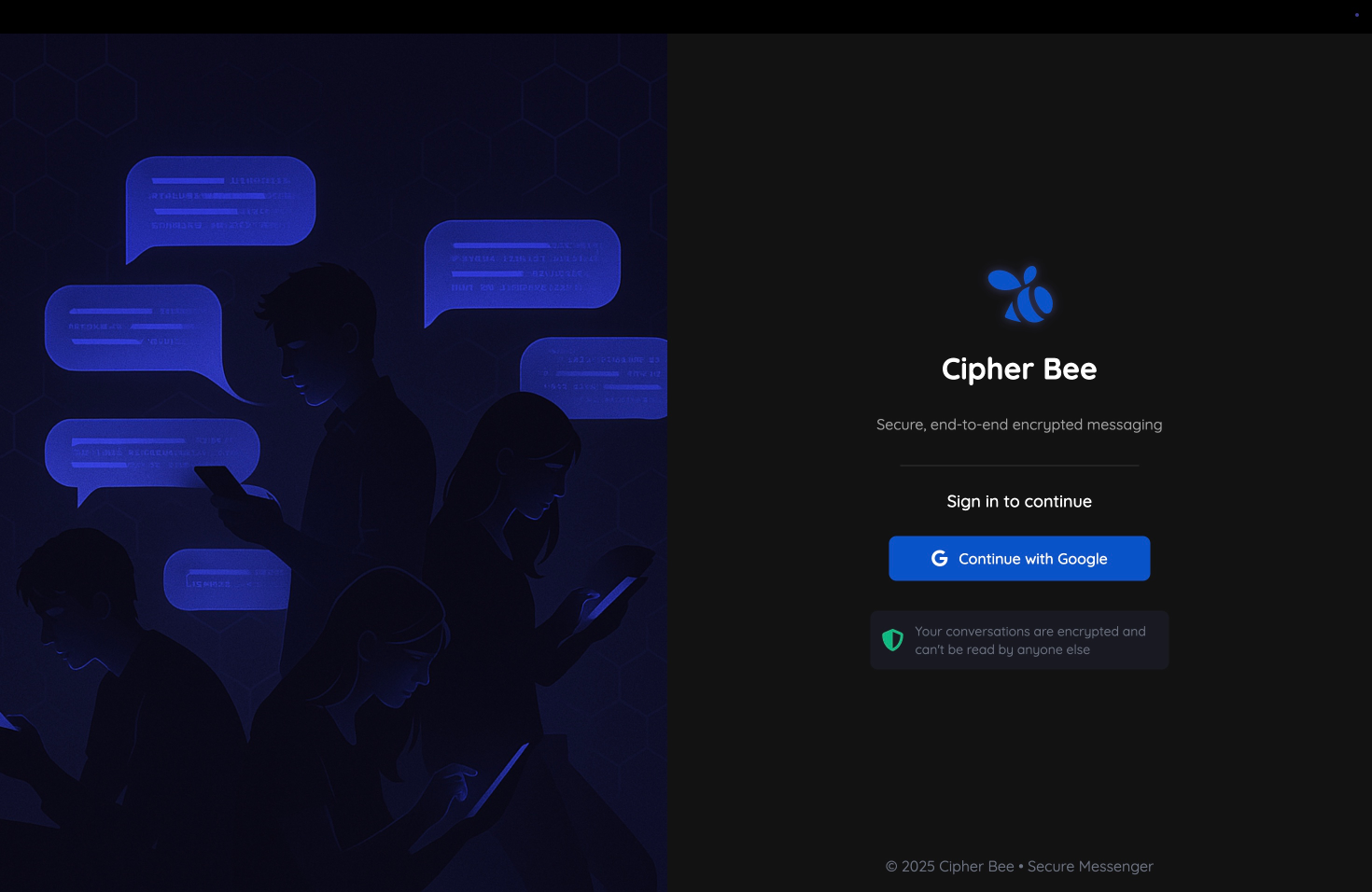CipherBee – A Cryptographically Secure Messaging App for Learning End-to-End Encryption


Building a real-time messaging app where even I, as the developer, cannot read your messages – because sometimes the best way to learn cryptography is to build something that actually encrypts using AES-GCM 256-bit encryption and Web Crypto APIs.
🔐 Security First
⚠️ Educational Purpose: Built for learning cryptography concepts - explore how end-to-end encryption works in practice!
🔗 Live Project: CipherBee Secure Messenger
📁 Source Code: Explore the cryptographic implementation
🪄 What Sparked This Project?
Picture this: I'm sitting in my "Cryptography and Network Security" class, drowning in theoretical concepts about AES-GCM encryption, initialization vectors, and key generation. While my classmates were probably planning their typical academic projects with conference paper presentations, my web developer brain started tingling with a wild idea.
"What if I actually built something that demonstrates end-to-end encryption in action?"
As someone who lives and breathes React code, I knew I could create something way more engaging than a theoretical report. I wanted to build a messenger app where the encryption is so solid that even I, the developer with full database access, couldn't peek at your conversations. The challenge was irresistible – combine my passion for web development with the academic goal of mastering cryptographic principles.
This wasn't just about getting good grades; it was about proving that cryptography isn't just theory locked away in textbooks – it's powerful, practical, and absolutely essential in today's digital world.
🧰 Tech Stack
Frontend & Development:
React 19 with TypeScript - Type-safe component architecture for handling sensitive cryptographic operations
Vite - Lightning-fast development with hot module replacement for rapid cryptography testing
React Router DOM - Seamless navigation between login and encrypted chat interfaces
CSS3 with custom variables - Clean, modern dark theme design emphasizing security aesthetics
Backend & Real-time Infrastructure:
Firebase Authentication - Google OAuth integration for seamless, secure user login
Cloud Firestore - Real-time database for storing encrypted messages (only ciphertext, never plaintext)
Firebase Hosting - Reliable deployment platform with global CDN
🔐 Cryptography Arsenal:
Web Crypto API - Browser-native AES-GCM encryption with 256-bit keys for maximum security
Custom Encryption Utilities - Built from scratch for educational understanding of cryptographic principles
Cryptographically Secure RNG - Proper random key generation using browser security APIs
Development & Deployment:
ESLint - Code quality and consistency for security-critical operations
Vercel - Production deployment with global CDN and HTTPS enforcement
I chose this stack because I wanted to focus purely on the cryptographic learning aspect without getting bogged down in backend complexity. Firebase handles the infrastructure, React provides the beautiful UI, and the Web Crypto API gives me access to industry-standard encryption algorithms. Plus, TypeScript ensures I don't make silly mistakes when handling sensitive cryptographic operations!
✨ Key Features
🔐 End-to-End Encryption
AES-GCM 256-bit Encryption - Every message is encrypted before it even touches Firebase - I literally cannot read your messages, even with database admin access!
Per-Conversation Keys - Each conversation gets its own unique encryption key, automatically generated using cryptographically secure random number generation
Client-Side Only Decryption - Keys never leave your browser, ensuring true end-to-end security
⚡ Real-Time Secure Messaging
Instant Message Delivery - Messages appear instantly using Firestore's real-time listeners with automatic decryption
Seamless Encryption Flow - Encryption and decryption happen transparently without blocking the user interface
Smart User Search - Find other users by email and start encrypted conversations instantly
👤 Secure Authentication
Google OAuth Integration - One-click login with your Google account - no passwords to remember or registration forms
Secure Session Management - Firebase handles authentication tokens with automatic refresh and secure storage
Privacy-First Design - Minimal data collection with focus on security over analytics
🎨 Security-Focused UI Design
Modern Dark Theme - Sleek interface that feels like a premium messaging app with security-first aesthetics
Visual Security Indicators - Lock icons and encryption badges that build user trust and communicate security status
Smooth Animations - Clean typography and intuitive user experience that doesn't compromise security
🚧 Challenges I Faced
The Encryption Key Storage Dilemma
My biggest headache was figuring out where to store encryption keys. I needed them to be accessible to conversation participants but completely useless to anyone else. After lots of research, I decided to store the exported keys directly in the conversation documents – it's a tradeoff between convenience and security, perfect for a learning project that demonstrates real cryptographic challenges.
Asynchronous Decryption Chaos
Handling real-time message decryption while maintaining UI responsiveness
was like solving a puzzle blindfolded. Messages would arrive encrypted, but
I needed to decrypt them individually without blocking the interface. I
ended up implementing a Promise-based decryption system that processes
messages in batches using Promise.all() for optimal
performance.
Firebase Query Index Requirements
Firestore threw compound query errors at me left and right. I learned the
hard way that real-time queries with multiple where clauses and orderBy need specific database
indexes. The solution involved graceful error handling and understanding how
NoSQL indexing actually works in production environments.
TypeScript + Crypto APIs Integration
The Web Crypto API returns ArrayBuffers and CryptoKeys – objects that don't play nicely with TypeScript's type system initially. I
spent hours figuring out proper type definitions and creating utility functions
for converting between ArrayBuffers and Base64 strings while maintaining type
safety.
UI State Management During Encryption
Keeping the UI responsive while encryption/decryption operations happen in the background required careful state management. I implemented loading states and optimistic updates to make the experience feel instant, even when dealing with cryptographically intensive operations.
📚 What I Learned
Cryptography is Beautiful (and Complex) - I went from thinking "AES is just an algorithm" to understanding initialization vectors, key derivation, and why GCM mode is perfect for authenticated encryption
Real-Time Data Architecture - Firebase's real-time listeners are powerful, but managing state updates, preventing memory leaks, and handling connection drops requires careful planning and extensive testing
TypeScript for Security - Working with sensitive operations like key generation and message encryption, TypeScript's strict typing caught several potential bugs before they could cause security issues
UI/UX for Security Features - Learned how to design interfaces that communicate security to users without being overwhelming – like subtle encryption badges and lock icons that build trust
Firebase Security Rules - Understanding how to structure database security rules to allow encrypted data access while preventing unauthorized reads was like learning a new programming language
Web Crypto API Mastery - Deep dive into browser-native cryptographic functions, understanding their limitations and security guarantees
📈 Optimisations & Performance
Efficient Cryptographic Operations
Since this was built as a learning project rather than a production app, I
focused on educational clarity over mobile optimization. However, I still
implemented efficient message decryption by batch processing messages using Promise.all() to maximize browser performance during cryptographic operations.
Smart React State Management
Used React's state management carefully to prevent unnecessary re-renders during encryption operations. Implemented proper cleanup for real-time listeners and optimized Firebase queries to minimize database reads while maintaining security.
Security-First Architecture
Structured the application with security as the primary concern - lazy loading components like the chat interface, using CSS custom properties for consistent theming, and ensuring all cryptographic operations happen client-side to maintain the zero-knowledge principle.
🙌 Final Thoughts
Building CipherBee was like solving a fascinating puzzle where every piece taught me something new about cryptography, real-time web applications, and security-first design. My biggest win? Actually understanding how encryption works in practice, not just in theory.
The moment when I realized I genuinely couldn't read the messages in my own database was both thrilling and terrifying. It proved that the encryption was working as intended – even the developer with full system access was locked out of the actual message content. That's when I knew I had successfully implemented true end-to-end encryption.
If I were to build this again, I'd probably implement proper key exchange protocols (like Diffie-Hellman) and add message perfect forward secrecy. But for a cryptography class project, I'm incredibly proud of creating something that actually works and demonstrates real security principles in action.
Would I recommend this as a learning project? Absolutely! There's something magical about seeing your messages transform into unintelligible ciphertext and then decrypt perfectly on the other side. It makes all those cryptography lectures suddenly click into place.
Plus, building something with a world-class UI while learning complex security concepts? That's exactly the kind of challenge that makes me love being a developer. The intersection of beautiful design and bulletproof security is where the most interesting problems live.
This project proved that academic learning doesn't have to be theoretical and boring. Sometimes the best way to understand cryptography is to build something that actually encrypts, deploy it to the web, and see the security principles come alive in a real application.